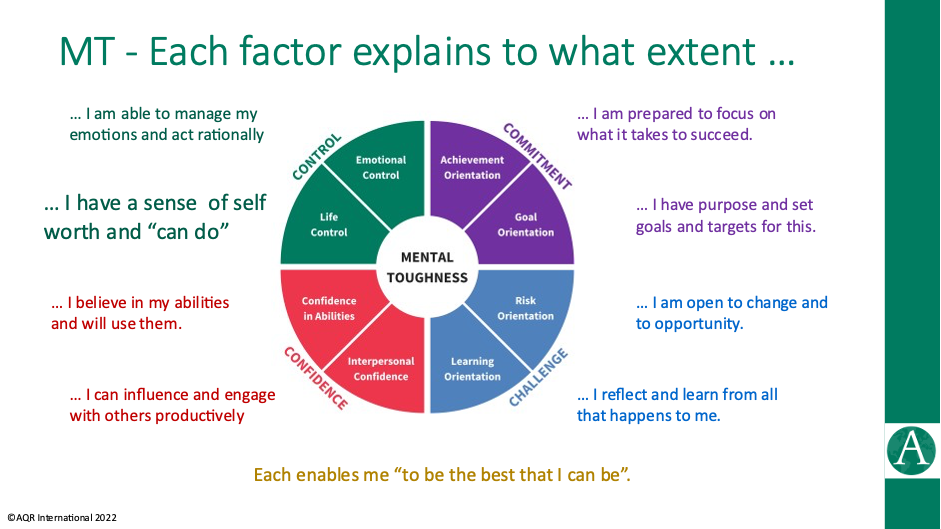“It’s not enough to have lived. We should be determined to live for something.” Winston Churchill
This is the third in a series of posts about the eight factors that form the mental toughness concept which is a personality trait that describes our mental responses, how we think, to stressors, challenges and opportunities that make up our life and work experiences.
Fundamentally important, it is a major influence on our behaviour – how we act.
Goal Orientation is one of the two factors that contribute to our overall sense of Commitment. Commitment describes the extent to which we “make promises” and the extent to which we “do what is needed to keep them”.
Goal Orientation addresses the first part. This describes the extent to which we know what we should achieve in life and work. It explores a form of visualisation – can we imagine and understand what we should achieve in life and why that is important or significant for us. That is about purpose.
And if purpose matters, can we articulate this in terms of goals and targets that are relevant and find them potentially motivating.
As with all the factors, it is possible to find two people, similar in all respects, where one can picture where they want to be at some future time or place whilst the other appears aimless and cannot see something to aim for that would inspire and excite them.
The difference lies in their respective mental approaches. This can be significant for well being and performance.
As with all the factors it is important not to be judgemental here. People are simply different. The challenge is to understand that difference and what it means for that individual and for others.
There can be an interesting implication for leadership here. Leaders generally bring purpose to a group or organisation. However, if you have a lot of goal oriented people, there can be a risk that their goals are not particularly well aligned with the leaders and conflict can arise.
On the other hand, if there are many who are not goal oriented, the leaders have an opportunity to share their goals with the followers, inspiring them with less risk of rejection.
This illustrates that the purpose of the mental toughness concept and its detail in the eight factors is for understanding. Ultimately to making the most of the situation can mean change but starts with understanding.
All too often, those with a different view are seen as the enemy. That inspires conflict, not cooperation.
This factor, like all the factors, is a spectrum with mental sensitivity at one end and mental toughness at the other. It is not a black and white idea – there are many shades in between. In fact, around 70% of a population will have mental responses that reflect elements of both.
And, although each of the factors is independent of the other, they can interplay to create different outcomes. There are at least 40,000 possible combinations at a base level.
So, two people, who are similar in terms of Goal Orientation, might differ in their response to tasks if one has a high level of, say, Confidence in their Abilities (and believes they have the skills to deal with the challenges that will go with the purpose) and the other has a low level (and doubt they have the knowledge or skill to deliver the purpose – even when they do!).
This illustrates that personality is complex and nuanced and how the mental toughness concept (and the MTQPlus) measure can bring that nuance to the practitioner.
The image helps us to get an insight into this. Think about how different levels of Life Control might result in different outcomes with different levels of the other seven factors.

There is another layer of complexity to consider. All things being equal, being more mentally tough will give an advantage to the individual. But not always.
It is perfectly possible for a mentally tough person to struggle and for the more mentally sensitive to thrive. The key is self-awareness – about how they are responding in their head. Ordinarily, this is invisible which is a major challenge for the practitioner and the individual.
If self-aware of one’s level of mental toughness, one can either develop it or one can adopt practices that help to compensate for the level of sensitivity.
This is the essence of coaching. Understanding what makes you tick and what gets in the way.
How can a mentally tough goal orientated person struggle? They can “set the bar too high”; they can set goals for everything and struggle to prioritise; they can intimidate others with their goals; they can strive for perfection when realism is a better option and can fail to see that others are not necessarily motivated by goals the way they are.
What are the positives for a more mentally sensitive person in this regard? They are more likely to be opportunistic in their approach to life and work; they can be more agile in letting go when it’s important to do so; they can be happy to accept others goals and challenges; they may be good at sensing when goals and the work that is needed to achieve them is likely to be too much.
Given this degree of nuance is true for all eight factors and that all interplay with one another, we now have a lens through which we can help people to look at themselves with all the complexity involved and understand exactly where their development needs might lie.
This illustrates that the mental toughness concept is about differences and not about “good or bad” or labelling people as types or colours. We are all remarkably different and similar.
There is evidence emerging that “one size fits all” approaches although targeted at individuals fail and can do more harm than good because they are not customised.
Assessment is a challenge. Because the factors are invisible and any one, or combination of factors, can be the explanation for a behaviour or wellbeing outcome, it can be very difficult to assess someone’s mental toughness profile with a realistic level of confidence. Fortunately, a by-product of the considerable research behind the concept has resulted in the development of a reliable and valid psychometric measure that assesses this and the other factors with a high re degree of reliability and validity.
The mental toughness concept and the MTQPlus measure represent a real advance in our understanding of individuals (and organisations). For practitioners who are engaged in developing people and organisations, understanding mental toughness goes beyond CPD. It should really be part of their armoury.
Like the image used in this post on Life Control and others in our ‘Eight Factors’ series? A set of downloadable posters are available here.

Doug Strycharczyk 2023


